When most people think of Florida, they think of sandy beaches, crystal-clear water, and amazing sunsets. They don’t think about the insects and arachnids that call Florida home. There are plenty of them – and some can deliver quite painful bites! But don’t worry, you don’t have to avoid exploring the Sunshine State. Just be aware of the insects and arachnids that could potentially inflict pain should they bite or sting you.
This article looks at 10 Florida insects and arachnids you’d not want to meet face-to-face! We’ve also ranked them by how painful their bites/stings can be.
10 Florida Bugs That Bite or Sting
Let’s start with the easy part – defining what a bug is. A bug is a type of insect belonging to an order of insects known as Hemiptera. This order contains over 80,000 different species within groups. Technically, all bugs are insects, but not every insect is classified as a bug.
However, in a casual context, these two words are used interchangeably, with the word “bug” referring to any insect and other small arthropods which are not insects. To help you identify Florida’s nasty bugs, we’ve adopted the definition as well. So, by saying “bugs,” we mean small insects and other land-living arthropods, such as spiders. Without further ado, let’s go on a tour of Florida’s biting bugs.
1. Fire Ants
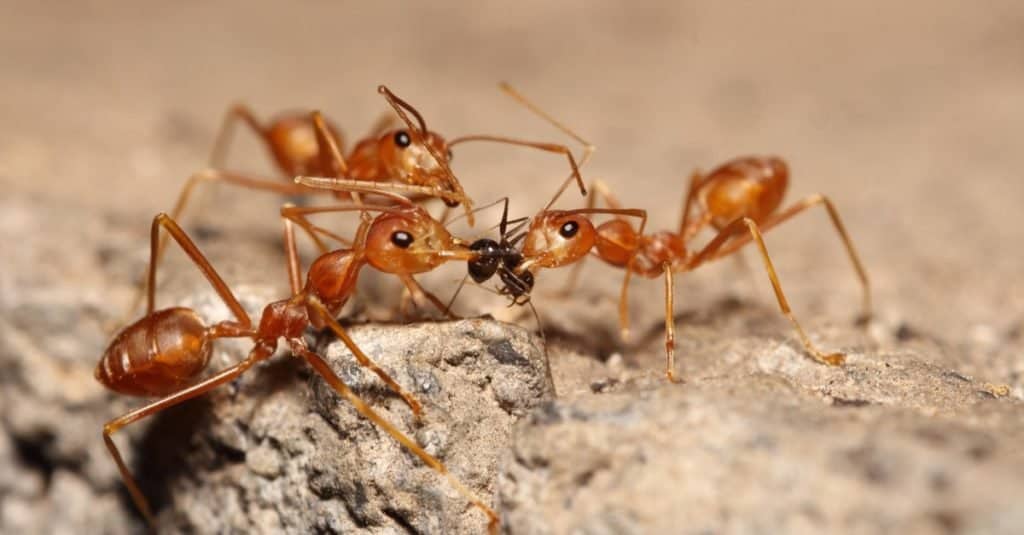
Fire ants build large mounds but can be found in tree stumps, decaying logs, and even inside your home.
©sarawuth wannasathit/Shutterstock.com
If you’re wondering where you may stumble upon fire ants, you should know that these insects build large mounds but can be found in tree stumps, decaying logs, and even inside your home. These small, aggressive ants deliver one of the most painful stings you can experience in Florida. A single fire ant can sting multiple times, and if you’re unfortunate, you’ll notice as soon as it happens since they cause immediate excruciating pain and redden the skin.
Florida’s most notorious fire ants are the red imported fire ant (Solenopsis invicta) and the tropical fire ant (Solenopsis geminata). Both species are almost identical, sharing red-brown bodies and painful stings. However, red imported fire ant sting causes pimple-like lesions that often result in white pustules and can be painful for several days. The native fire ant sting is less severe, but both can cause allergic reactions.
2. Scorpions

Florida scorpion stingers are rarely fatal, but their venom can cause severe pain and swelling.
©Ernie Cooper/Shutterstock.com
Florida scorpion stingers are rarely fatal, but their venom can cause severe pain and swelling. You may even experience numbness and tingling in the sting area or a burning sensation that can last several hours. The injected site may feel hot to the touch and be accompanied by a red welt. The venom can cause an allergic reaction.
These arthropods’ sting is excruciating because the venom triggers the pain signals in the brain, allowing more pain signals to be transmitted.
The most common scorpion species found in Florida are:
- Florida bark scorpion
- The Hentz striped scorpion
- Guiana striped scorpion
3. Spiders

Wolf spider venom can immobilize an insect.
©iStock.com/Henrik_L
Another common Florida ‘bug’ that can bite and sting you is a spider. Spiders are classified as air-breathing arthropods in the class Arachnida. Although spiders are shy and only some are dangerous, they can bite and hurt you, albeit with varying levels of success. Florida’s three most painful and venomous spider bites belong to the brown recluse, the black widow, and the wolf spider.
Among the three, female widow spiders are the most dangerous and quick to bite. Widow venom is toxic, and their bites can cause severe pain, and in rare cases, it can be fatal. On the other hand, the wolf spider may look scary, but they are not generally dangerous. They stay away from humans but can bite if they feel trapped. Though wolf spider venom can immobilize an insect, it is not as poisonous to humans.
The brown recluse spider is not native to Florida but has been found in the state. They are not aggressive, but it is safe to avoid them as they can bite if provoked. Brown recluse venom is necrotic, and their bites can cause an itchy rash and intense pain.
4. Buck Moth Caterpillar

Buck moth caterpillars can cause a painful sting, inducing swelling, itching, redness, and even a nasty rash.
©iStock.com/Oleg Marchak
Buck moth caterpillars are insects you definitely don’t want to mess with! These fuzzy little insects are covered in venomous spines attached to a poison sac. They can cause a painful sting, inducing swelling, itching, redness, and even a nasty rash. Sometimes, the sting can be so painful that it requires medical attention. These pesky caterpillars can be found outdoors, often lurking in brush and shrubbery. They can also be found in large, beautiful oak trees that line city streets and parks.
5. Bees and Wasps
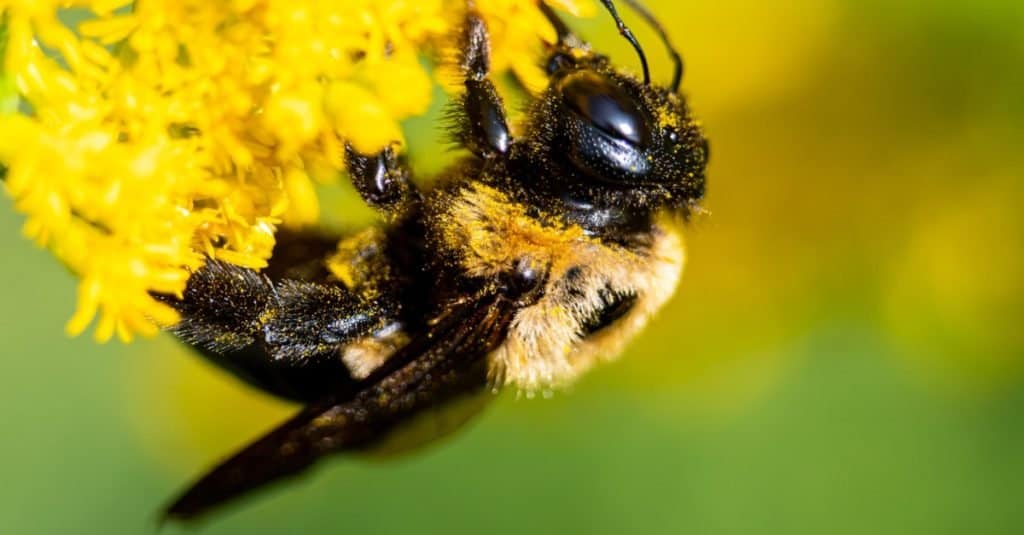
Bumblebees are fuzzy and often covered in soft hairs.
©Brier Mitchell/Shutterstock.com
Bees and wasps stings can be painful, and, unfortunately, there are over 320 species of bees in Florida to watch out for! Most species are social creatures, but they attack when they feel threatened. They attack by stinging and injecting venom, which causes localized swelling and pain that can feel like a needle stick. The stinger is often left in the wound, and a welt or a swollen red bump may appear within a few minutes of being stung.
Bumblebees and honey bees are common in Florida and can be identified by their striped black and yellow patterns. Bumblebees are fuzzy and often covered in soft hairs, and they tend to create colonies underground or in old rodent burrows. They’re also highly social, so if you see one bumblebee, there are likely more in the area.
Honey bees form colonies above ground, where they create waxy honeycomb structures. Both bumblebees and honeybees have stingers and should be given a wide berth! Fortunately, these buzzing critters only sting once unless you somehow stumble upon a swarm.
Like bees, wasps are social insects and will also sting when threatened. Yellow jackets, paper wasps, and red wasps are the most prevalent species in Florida. They are also the most aggressive when provoked and can sting multiple times. If one of these critters is hurt, it will release an alarm pheromone which can cause other wasps in the colony to attack!
6. Yellow Flies
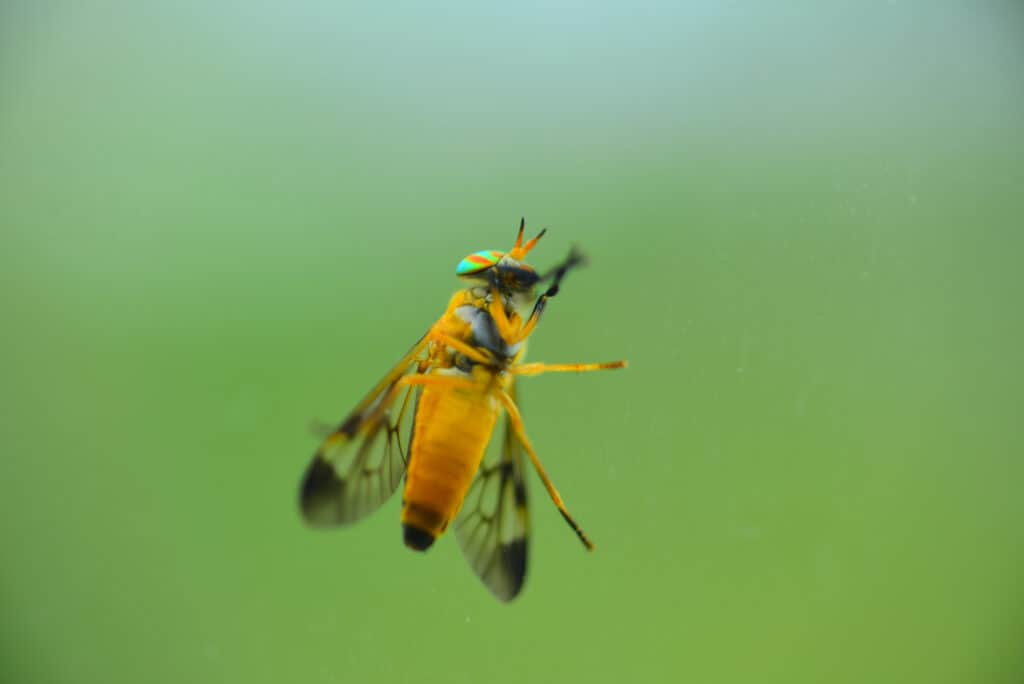
Yellow flies are fierce bitters with piercing mouthparts that they use to draw blood, leaving behind an itchy and burning sensation.
©iStock.com/cturtletrax
If you hear the name yellow flies in Florida, it might send chills down your spine. These pesky flies are referred to as aggressive yellow-bodied biting flies. They are most active during midmorning and early afternoon and can be found hovering around warm, wet areas. They are fierce bitters with piercing mouthparts that they use to draw blood, leaving behind an itchy and burning sensation. Yellow flies share some characteristics with mosquitoes, wherein only the females are responsible for biting. The males feed on nectar and pollen.
7. Biting Midges

Midges usually live in damp, marshy areas and are especially active in the morning and evening.
©Henrik Larsson/Shutterstock.com
Also known as ‘no-see-ums,’ these tiny insects are found in aquatic and semi-aquatic regions. They swarm around your body when you least expect it. Midges are so small, measuring less than 0.12 inches long, and hard to spot that you might not even know you’ve been bitten until the lesion starts itching. While their bites may not be particularly painful, they make a small cut on their victim’s skin using their small cutting teeth. At the same time, they inject venom found in their saliva to prevent blood clotting.
Midges usually live in damp, marshy areas, and they are especially active in the morning and evening. Despite their small size, it’s important to protect yourself if you’re in an area where they swarm.
8. Bed Bugs
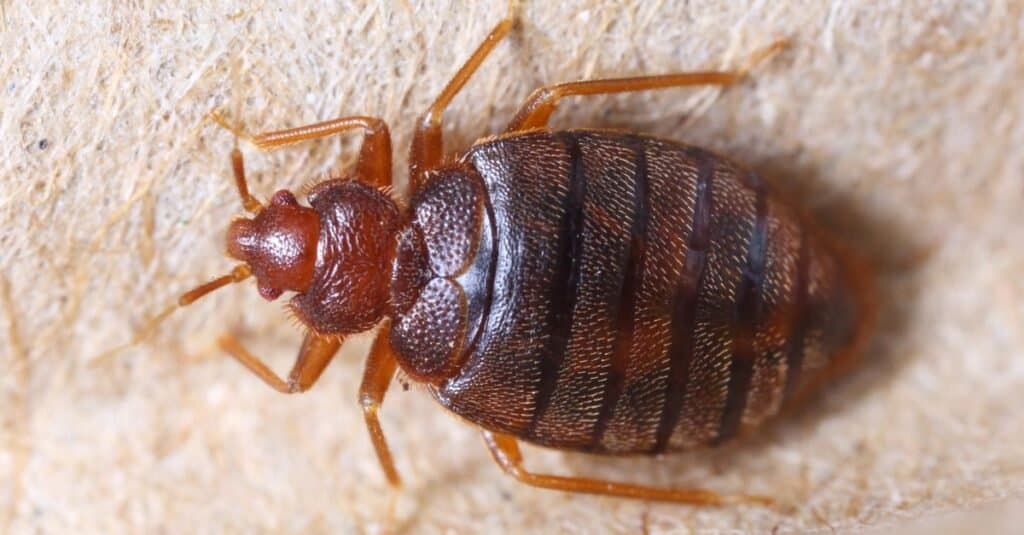
Bed bugs are small insects that feed on human and animal blood.
©7th Son Studio/Shutterstock.com
Bed bugs are small insects that feed on human and animal blood. They can be found in beds, furniture, carpets, soft furnishings, and other warm places. Nymphs are only about the size of a pencil point, and adults reach the size of an apple seed. They are reddish-brown, and their bites can be painful and itchy. They typically feed at night, and the only way to discover them is to look for tiny stains on the mattress from their droppings or bite marks on the skin.
If you have a bed bug infestation, getting professional help to wipe them out as soon as possible is important. Bed bugs have been known to spread quickly and are difficult to remove without a proper plan.
According to research, the cities in Florida with the worst bed bug infestations are Tampa, Orlando, Daytona Beach, Melbourne, Miami, and Fort Lauderdale. If you live in one of these cities, it’s especially important to be on the lookout for bed bugs.
9. Mosquitoes
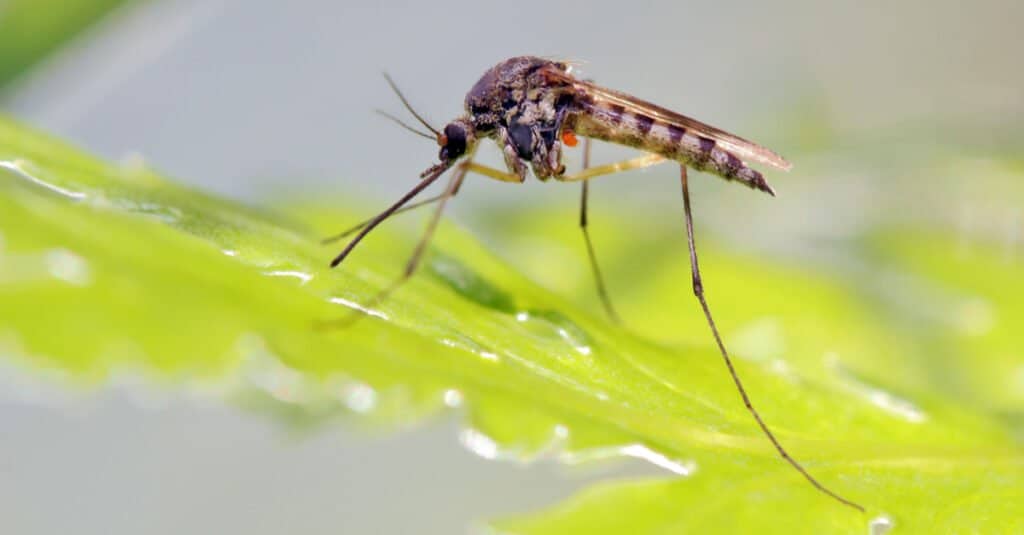
Mosquitoes are among the most dangerous insects in Florida.
©Achkin/Shutterstock.com
Mosquitoes are the most common insects in Florida, and unfortunately, they are also among the most dangerous. Male mosquitoes don’t bite or feed on blood, and their proboscis is not sharp enough to pierce human skin. Conversely, female mosquitoes have a proboscis that can easily penetrate the skin and extract blood.
A single bite from a female mosquito can cause itchy, red welts and swollen bumps. They can even transmit diseases like the West Nile virus. When they bite, they release saliva, which can cause an allergic reaction. Mosquito-borne diseases in this state include Eastern equine encephalitis and St. Louis encephalitis.
The best-known ways to control mosquito bites are:
- Eliminate standing water sources
- Wear protective clothing and use insect repellents
- Staying inside during peak mosquito activity times (dusk to dawn)
10. Chiggers

Chiggers are only harmful to humans in their larval stage.
©iStock.com/dna_beeb
Chiggers are only harmful to humans in their larval stage. Larval mites attach themselves to human skin and feed on tissue and lymph fluid. Unlike other insects and bugs, chiggers do not feed on their hosts’ blood. Instead, they inject enzymes that dissolve their hosts’ skin tissues. They then suck up these dissolved tissues once they are liquefied. Chiggers typically live on a human host for between one to three days, although some may succumb within a few hours. The side effects of their bites occur four to eight hours after the initial bite. However, once the welts form, they may last up to two weeks.
Up Next:
- Do Bumble Bees Sting?
- Bee Lifespan: How Long Do Bees Live?
- Discover 5 Amazing Animals Migrating to Florida This Winter
The photo featured at the top of this post is © Pavel Krasensky/Shutterstock.com
Sources
- ESPN Southwest Florida, Available here: https://espnswfl.com/listicle/11-florida-bugs-that-can-kill-you-or-at-least-ruin-a-perfectly-good-day/
- LawnStarter, Available here: https://www.lawnstarter.com/blog/florida/orlando-fl/bugs-that-bite-and-sting-in-orlando/#10-mosquitoes
- Women's Health, Available here: https://www.womenshealthmag.com/health/a19997589/dangerous-bug-bites/
- University of Florida Extension, Available here: https://edis.ifas.ufl.edu/publication/IG099
Thank you for reading! Have some feedback for us? Contact the AZ Animals editorial team.






